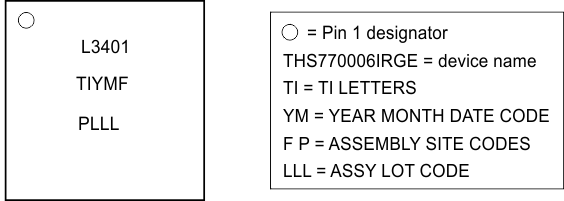SBOS695A August 2014 – December 2014 LMH3401
PRODUCTION DATA.
- 1 Features
- 2 Applications
- 3 Description
- 4 Revision History
- 5 Device Comparison Table
- 6 Pin Configuration and Functions
- 7 Specifications
- 8 Parameter Measurement Information
- 9 Detailed Description
-
10Application and Implementation
- 10.1 Application Information
- 10.2 Typical Application
- 10.3 Do's and Don'ts
- 11Power-Supply Recommendations
- 12Layout
- 13Device and Documentation Support
- 14Mechanical, Packaging, and Orderable Information
13 Device and Documentation Support
13.1 Device Support
13.1.1 Device Nomenclature
 Figure 73. Device Marking Information
Figure 73. Device Marking Information
13.2 Documentation Support
13.2.1 Related Documentation
For related documentation see the following:
- THS4541 Data Sheet, SLOS375
- ADS12D1800RF Data Sheet, SNAS518
- ADS5424 Data Sheet, SLWS157
- ADS5485 Data Sheet, SLAS610
- ADS6149 Data Sheet, SLWS211
- ADS4149 Data Sheet, SBAS483
- LMH3401EVM Evaluation Module, SBOU124
- AN-2188 Between the Amplifier and the ADC: Managing Filter Loss in Communications Systems, SNOA567
- AN-2235 Circuit Board Design for LMH6517/21/22 and Other High-Speed IF/RF Feedback Amplifiers, SNOA869
13.3 Trademarks
Marki is a trademark of Marki Microwave, Inc.
Rohde & Schwarz is a registered trademark of Rohde & Schwarz.
All other trademarks are the property of their respective owners.
13.4 Electrostatic Discharge Caution

This integrated circuit can be damaged by ESD. Texas Instruments recommends that all integrated circuits be handled with appropriate precautions. Failure to observe proper handling and installation procedures can cause damage.
ESD damage can range from subtle performance degradation to complete device failure. Precision integrated circuits may be more susceptible to damage because very small parametric changes could cause the device not to meet its published specifications.
13.5 Glossary
SLYZ022 — TI Glossary.
This glossary lists and explains terms, acronyms, and definitions.